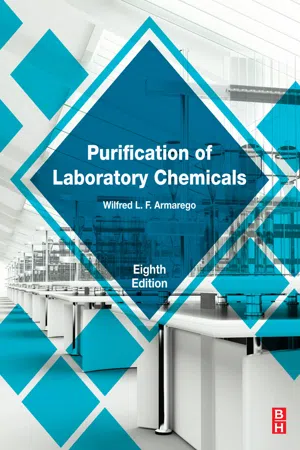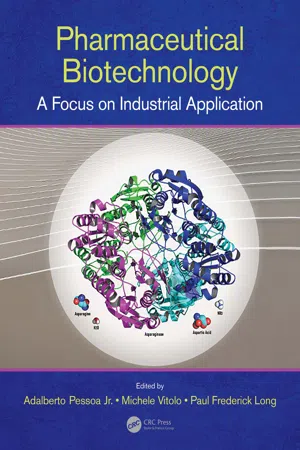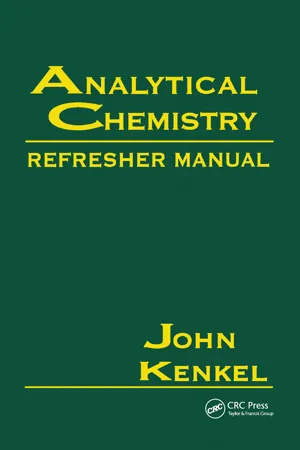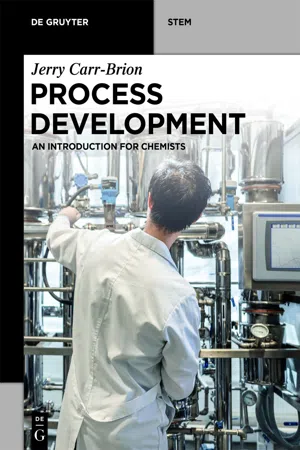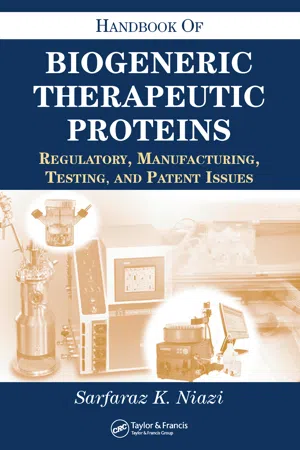Chemistry
Purification
Purification in chemistry refers to the process of removing impurities from a substance to obtain a pure form. This can be achieved through various methods such as filtration, distillation, crystallization, and chromatography. Purification is essential in chemistry to ensure the quality and integrity of substances used in experiments and industrial processes.
Written by Perlego with AI-assistance
Related key terms
Related key terms
1 of 4
Related key terms
1 of 3
6 Key excerpts on "Purification"
- eBook - ePub
Biopharmaceutical Manufacturing
Principles, Processes, and Practices
- Gary Gilleskie, Charles Rutter, Becky McCuen(Authors)
- 2021(Publication Date)
- De Gruyter(Publisher)
Chapter 8 Purification operations: chromatographyAt the end of the harvest stage, the active product is typically dissolved in a clarified – that is, solids-free – aqueous solution. A sample would likely look “clean” and clear, yet numerous soluble impurities are present that must be removed to levels low enough to ensure no risk to a patient. Liquid chromatography is the unit operation in biopharmaceutical processing most commonly used to remove these soluble impurities from the product and, therefore, is critical for meeting product quality attributes related to purity.The topic of chromatography in biopharmaceutical processes is a big one. The processes occurring at the molecular level to create separation are complex. There are numerous types of chromatography media to choose from, numerous process parameters that can be varied in the design of chromatography steps to optimize performance, and a number of validation considerations required for current Good Manufacturing Practice (cGMP) processing. This chapter attempts to succinctly explore all of these topics, by specifically addressing the following questions:- What are the impurities that must be removed in a process to produce a drug product safe for patients?
- How does separation of the product from impurities occur in chromatography?
-
Chromatography utilizes a stationary phase that interacts with solutes in the liquid feed to enable separation. What different chemistries are utilized on these stationary phases to create separation for biopharmaceutical processes?
- eBook - ePub
- W.L.F. Armarego(Author)
- 2017(Publication Date)
- Butterworth-Heinemann(Publisher)
Chapter 2Chemical Methods Used in Purification
Abstract
Describes the chemical procedures that have been used in the literature to purify a variety of substances with a large range of chemical reactivity. This invariably involves conversion into some suitable derivative which is more readily purified, followed by regeneration of the original material. Recent advances in chemical methods are also discussed. Six useful tables are included. A bibliography of recent references is provided.Keywords
Complexation; Derivatives; Distillation; Extraction; Fluorochromes; Ion-exchange resins; Metal hydrides; Metal impurities; Organic compounds & metal salts; Precipitation; TablesGeneral Remarks
Greater selectivity in Purification can often be achieved by making use of differences in chemical properties between the substance to be purified and the contaminants. Unwanted metal ions may be removed by precipitation in the presence of a collector (see below). Sodium borohydride and other metal hydrides transform organic peroxides and carbonyl-containing impurities such as aldehydes and ketones in alcohols and ethers. Many classes of organic chemicals can be purified by conversion into suitable salts or derivatives, followed by regeneration. This chapter describes some relevant procedures.Removal of Traces of Metals from Reagents
Metal Impurities
The presence of metal contaminants in reagents may sometimes affect the chemical or biochemical outcomes of an experiment. In these cases, it is necessary to purify the reagents used. Metal (and other) impurities can be determined qualitatively and quantitatively by atomic absorption spectroscopy (AAA), x-ray photoelectron spectroscopy (XPS), various mass spectrometric methods and/or inductively coupled plasma mass spectrometry (ICP-MS) (see Chapter 1, Question of Purity - eBook - ePub
Pharmaceutical Biotechnology
A Focus on Industrial Application
- Adalberto Pessoa, Michele Vitolo, Paul Frederick Long(Authors)
- 2021(Publication Date)
- CRC Press(Publisher)
The products of the biotechnology industry are diverse in composition (organic acids, antibiotics, antibodies, polysaccharides, hormones, amino acids, peptides and proteins) and in their location in relation to the producing cell. As a result of this diversity, there are no Purification processes of general application. However, conceptually, the process can be divided into four main steps: separation of cells and their fragments (clarification) from the aqueous medium; concentration and/or Purification, which comprises the separation of the target molecule, for example, a protein from molecules with significantly different physico-chemical characteristics (water, ions, pigments, nucleic acids, polysaccharides and lipids); Purification which frequently comprises separating classes of molecules with some similar physico-chemical characteristics, for example, proteins; and finally operations for the final packaging of the product. In addition, for cell-associated products, it is necessary to disrupt the cells after clarification (Costa-Silva et al., 2018).The completion of each step does not necessarily comprise a single unit operation. For example, following salt precipitation, dialysis is required to adjust the ionic strength to levels appropriate to a chromatography. On the other hand, there are products (organic acids and industrial enzymes) whose application does not require a high degree of purity, so that chromatographic operations are not necessary. However, in any situation, reducing the number of steps is of fundamental importance for the viability of the process. For example, if each unit operation yields 90% of a product, the application of nine operations will lead to a final yield of only 40%.The definition of a unit operation in a Purification process depends on the use of the target molecule, its physico-chemical characteristics as well as those of the impurities. Products intended for therapeutic and diagnostic use are, of course, those which require a greater degree of purity, and therefore, for these molecules, the Purification process is complex. A measure of this complexity is the cost of the Purification process in relation to the final cost of the product, which can reach 80%. - eBook - ePub
- John Kenkel(Author)
- 2020(Publication Date)
- CRC Press(Publisher)
Recrystallization is a Purification technique for a solid, usually organic. The separation is based on the solid’s solubility in a liquid solvent. A solvent is chosen such the solid is sparingly soluble at room temperature, but whose solubility increases considerably at higher temperatures. Both soluble and insoluble impurities are considered to be present, and the procedure removes both if their concentrations are not too large.The key to the procedure is to use a minimum amount of solvent, such that the solid will just dissolve at the elevated temperature (usually the boiling point, if the solid is stable at that temperature). While maintaining this elevated temperature, any impurity that has not dissolved can be filtered out. The “insoluble” impurities are thus removed.Soluble impurities, however, are still present in the filtrate. This is where the minimum amount of solvent comes into play. The procedure calls for the temperature to be lowered back to the original value. The soluble impurities will stay dissolved if their solubility has not been exceeded (if they are present in a small amount). However, the solid being purified will have its solubility exceeded. Since the minimum amount of solvent was used to just dissolve the solid at the elevated temperature, it will thus precipitate from the solution. The solid, presumably purified, can then be filtered and dried. It may be necessary to perform the recrystallization several times in order to get the desired purity.8.3 DISTILLATION
Distillation is a method of Purification of liquids contaminated with either dissolved solids or miscible liquids. The method consists of boiling and evaporating the mixture followed by recondensation of the vapors in a “condenser,” which is a tube cooled by isolated, cold tap water. The theory is that the vapors (and thus recondensed liquids) will be purer than the original liquid. The separation is based on the fact that the contaminants have different boiling points and vapor pressures than the liquid to be purified. Thus, when the liquid is boiled and evaporated, the vapors (and recondensed liquids) created have a composition different from the original liquid. The substances with lower boiling points and higher vapor pressures are therefore separated from substances that have high boiling points and low vapor pressures. - eBook - ePub
Process Development
An Introduction for Chemists
- Jerry Carr-Brion(Author)
- 2022(Publication Date)
- De Gruyter(Publisher)
Chapter 3 Purification3.1 Measuring purity
It is one thing to have a process to make a compound and another to be able to consistently produce a product with acceptable purity. Firstly, you have to consider how the purities of the intermediates and the final product are going to be measured. This is the preserve of analytical development. In some companies, analytical development chemists are integrated into the process development department; in others, there is a separate analytical development department; and in some, there is a single analysis department encompassing both analytical development and quality control. All these three set-ups have their pros and cons, and it is not infrequent for senior management to order a change from one format to another.The development of suitable analytical methods for a new compound and its intermediates is a challenging process, and there are many factors to consider, including selectivity, linearity, sensitivity and precision. It is unlikely that a method quickly produced by a development chemist one Friday afternoon will be the one that is finally chosen. In most cases, the analytical profiles for a final product and its intermediates are run by reversed-phase high-performance liquid chromatography (HPLC) or ultra-HPLC with UV detection. The percentage area value for the main peak from such runs is often referred to as ‘the purity’, although there are many reasons why it is unlikely to correspond to the actual purity. The response factors for the various peaks will probably differ, particularly if different chromophores are present, and there may be impurities present that aren’t detected at all by UV. Other methods, such as HPLC with evaporative light scattering detection or GC, may be needed to analyse these. Common impurities not detected by UV include hexamethylsiloxane (Fig. 3.1 a) and hexaethylsiloxane (b), which tend to be formed from trimethylsilyl and triethylsilyl protecting groups, respectively. The latter compound is much less volatile, so is more likely to be a contaminant. Traces of long-chain aliphatics, either from oil pumps, oiled equipment or unintended coupling reactions, can also sometimes occur. The unintended reduction of aromatic rings, particularly some heterocyclic aromatics, during the reduction of other functional groups can lead to small amounts of unsaturated cyclic compounds that don’t show up on UV. It is always best to use as mild a reducing system as possible for the task in hand. Charged compounds, including inorganic counter-ions in pharmaceutical salts [100 - eBook - ePub
Handbook of Biogeneric Therapeutic Proteins
Regulatory, Manufacturing, Testing, and Patent Issues
- Sarfaraz K. Niazi(Author)
- 2002(Publication Date)
- CRC Press(Publisher)
8 Purification TechniquesIntroduction
The downstream Purification steps comprise the most important part of the manufacturing of therapeutic proteins. The upstream process accumulates a large number of impurities including viruses, electrolytes, and other uncharged degradation products and structurally related molecules. Cleaning out these unwanted components to a level where it can comply with compendial requirements where available is accomplished in the Purification steps. The chromatography techniques used can add contaminants of their own, causing protein degradation or modification of protein structure. Additionally, the yield obtained through the Purification process is critical in making the system commercially feasible. Establishing optimal separation on a cost-effective basis requires a good understanding of the physicochemical nature of the target protein, particularly its physical and chemical stability profile. The first part of this chapter deals with the properties of protein that can have a significant effect on its separation potential; this is followed by a description of the most commonly used chromatography techniques.Protein Properties
All proteins are made up of amino acids and may contain other molecules as well. Amino acid contain amino group (–NH2), a carboxyl group (–COOH), and an R group with a general formula, R-CH(NH2)-COOH. The R group differs among various amino acids. In a protein, the R group is also called a side chain. There are over 300 naturally occurring amino acids. There are 20 of interest to humans. The type of R attached determines if they would at neutral pH retain a negative charge (acidic, aspartic, and glutamic acid), positive charge (basic, lysine, arginine, and histidine), or are aromatic in nature (tyrosine, tryptophan, and phenylalanine), contain sulfur (cysteine and methion-ine), are uncharged hydrophilic (serine, threonine, asparagines, and glutamine), are inactive hydro-phobic (glycine, alanine, valine, leucine, and isoleucine), or have special structures (proline, where amino acid groups are not directly connected and thus appearing at the end of the peptide chain). These classifications are important in imparting certain properties to proteins, besides the charge, that should be evaluated in the selection of an appropriate separation procedure. For example, interaction between positive and negative R groups may form a salt bridge, which is an important stabilizing force in proteins. The disulfide bond formed between two cysteine residues provides a strong force for stabilizing the globular structure. A unique feature about methionine is that the synthesis of all peptide chains starts from methionine. Hydrophilic groups can form hydrogen bonds. The inactive hydrophobic amino acids are found inside the protein interior and do not form hydrogen bonds and rarely interact.
Index pages curate the most relevant extracts from our library of academic textbooks. They’ve been created using an in-house natural language model (NLM), each adding context and meaning to key research topics.
Explore more topic indexes
Explore more topic indexes
1 of 6
Explore more topic indexes
1 of 4

